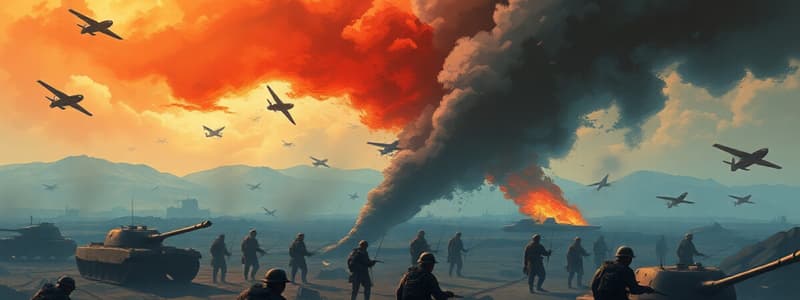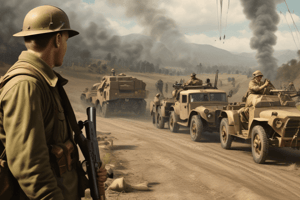Podcast
Questions and Answers
What was one of the primary reasons for the resentment in Germany after World War I?
What was one of the primary reasons for the resentment in Germany after World War I?
- Unexpected economic prosperity
- Integration into the Allied Powers
- Imposition of harsh penalties by the Treaty of Versailles (correct)
- The success of the League of Nations
Which countries were part of the Axis Powers during World War II?
Which countries were part of the Axis Powers during World War II?
- Germany, Italy, Japan (correct)
- Australia, Brazil, India
- Soviet Union, China, Canada
- France, Great Britain, the United States
What event marked the entry of the United States into World War II?
What event marked the entry of the United States into World War II?
- Fall of France
- Battle of Stalingrad
- Attack on Pearl Harbor (correct)
- D-Day invasion
Which of the following strategies was employed by the Allies in the Pacific Theatre?
Which of the following strategies was employed by the Allies in the Pacific Theatre?
What was a significant result of the Battle of Stalingrad?
What was a significant result of the Battle of Stalingrad?
Which military tactic did Germany primarily use to overwhelm opponents at the start of World War II?
Which military tactic did Germany primarily use to overwhelm opponents at the start of World War II?
What characterized the Eastern Front during World War II?
What characterized the Eastern Front during World War II?
Which event is known as the critical step in the liberation of Western Europe?
Which event is known as the critical step in the liberation of Western Europe?
What significant impact did the atomic bombings of Hiroshima and Nagasaki have on Japan?
What significant impact did the atomic bombings of Hiroshima and Nagasaki have on Japan?
Which organization was created after World War II to promote international cooperation and prevent future conflicts?
Which organization was created after World War II to promote international cooperation and prevent future conflicts?
What was a major consequence of World War II in global power dynamics?
What was a major consequence of World War II in global power dynamics?
Which key figure was the leader of Nazi Germany during World War II?
Which key figure was the leader of Nazi Germany during World War II?
What technological advancement did World War II significantly contribute to?
What technological advancement did World War II significantly contribute to?
Flashcards
The Holocaust
The Holocaust
The systematic and brutal murder of approximately six million Jews by Nazi Germany and its collaborators during World War II. This horrific event is known as one of the most tragic and devastating atrocities in human history.
Atomic bombings of Hiroshima and Nagasaki
Atomic bombings of Hiroshima and Nagasaki
The United States used atomic bombs on the Japanese cities of Hiroshima and Nagasaki in 1945, leading to Japan's unconditional surrender and the end of World War II. This event had profound and lasting consequences, including the emergence of the nuclear age and the Cold War.
Creation of the United Nations
Creation of the United Nations
The establishment of the United Nations in 1945 was a decisive step towards promoting international cooperation and preventing future global conflicts. The UN aims to maintain international peace and security, develop friendly relations between nations, and improve the lives of people around the world.
Shift in global power dynamics
Shift in global power dynamics
Signup and view all the flashcards
Technology and Warfare
Technology and Warfare
Signup and view all the flashcards
World War II (WWII)
World War II (WWII)
Signup and view all the flashcards
Treaty of Versailles
Treaty of Versailles
Signup and view all the flashcards
Blitzkrieg
Blitzkrieg
Signup and view all the flashcards
Battle of Stalingrad
Battle of Stalingrad
Signup and view all the flashcards
D-Day
D-Day
Signup and view all the flashcards
Battle of Midway
Battle of Midway
Signup and view all the flashcards
Island hopping
Island hopping
Signup and view all the flashcards
Attack on Pearl Harbor
Attack on Pearl Harbor
Signup and view all the flashcards
Study Notes
Introduction to World War II
- World War II (WWII) was a global war lasting from 1939 to 1945.
- It involved most world countries, including major powers, forming opposing alliances: Allies and Axis.
- Over 100 million personnel from over 30 countries participated.
- The war resulted in 70 to 85 million deaths, making it the deadliest conflict in history.
Causes of WWII
- The Treaty of Versailles, ending WWI, penalized Germany heavily, fueling resentment and instability.
- Aggressive nationalism and expansionist ideologies arose in Germany, Italy, and Japan, driven by economic hardship and territorial desires.
- The League of Nations failed to prevent further aggression.
- The 1930s global economic crisis exacerbated social and political tensions.
Key Players and Alliances
- Allied Powers: Primarily France, Great Britain, the United States, and the Soviet Union.
- Axis Powers: Primarily Germany, Italy, and Japan.
- Other countries joined based on regional conflicts and political agendas.
- Alliance systems intensified the global conflict.
Major Theatres of War
- European Theatre: Germany's invasion of Poland in 1939 began the war.
- German Blitzkrieg tactics initially overwhelmed opponents.
- The Western Front saw intense fighting and France's fall.
- The Eastern Front endured brutal combat and immense casualties.
- The Battle of Britain demonstrated British resolve and air power.
- Pacific Theatre: Japan's attack on Pearl Harbor in 1941 brought the US into the war.
- Extensive naval and air battles took place in the Pacific and Asia.
- Island hopping campaigns enabled Allied gains.
Key Battles and Events
- Battle of Stalingrad (1942-1943): A turning point in the European Theatre, decimating German forces and altering momentum.
- D-Day (1944): Allied invasion of Normandy, a crucial step in liberating Western Europe.
- Battle of Midway (1942): A pivotal naval battle in the Pacific, turning the tide of the Pacific campaign.
- Atomic bombings of Hiroshima and Nagasaki (1945): The US used atomic weapons, forcing Japan's surrender.
Consequences of WWII
- Massive loss of life and devastation: The war brought widespread suffering, death, and destruction globally.
- Creation of the United Nations: Established for conflict prevention and international cooperation.
- Shift in global power dynamics: The US and Soviet Union became superpowers, leading to the Cold War.
- Reestablishment of democratic values: Allied success aided in restoring democratic principles in many regions.
- Realignment of international alliances: World politics fundamentally changed as alliances were dismantled and new ones formed.
Key Figures
- Adolf Hitler: Leader of Nazi Germany, instigating the European conflict.
- Benito Mussolini: Fascist leader of Italy.
- Winston Churchill: British Prime Minister during the war.
- Franklin D. Roosevelt: American President during the war.
- Joseph Stalin: Soviet leader during the war.
The Holocaust
- The systematic persecution and murder of approximately six million Jews by Nazi Germany and collaborators became a defining atrocity.
- The Holocaust was part of a broader pattern of targeting and eliminating groups deemed undesirable.
- It highlights the dangers of extreme nationalism and racism.
Technology and Warfare
- The war drove significant advancements in military technology, including radar, jet aircraft, and submarines.
- The development of nuclear weapons significantly impacted global politics.
- Advancements also occurred in other areas such as medicine and communication.
Studying That Suits You
Use AI to generate personalized quizzes and flashcards to suit your learning preferences.




